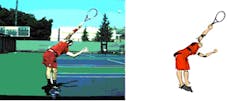Motion capture helps researchers analyze kinematics of tennis
A researcher at Ohio State University (Columbus, OH, USA) has developed a marker-less motion capture system that is offering fresh insights into tennis injuries.
Traditional motion capture technology works by attaching markers to a subject’s skin or clothing and tracking them as the subject moves.
However, the markers can emit an electronic signal or reflect light, and the associated wiring and other equipment can limit or otherwise influence people’s movement. Moreover, the tracking has to take place in a laboratory setting, where lighting and background are carefully controlled.
But Alison Sheets and her colleagues are working to do away with the markers and take motion capture out of the laboratory.
For a project at Stanford University -- where Sheets was a postdoctoral researcher before moving to Ohio State -- she was part of a team that designed a system of eight video cameras that record a person’s movements at the same time, each shooting from a different angle.
A computer program then combines the images to identify the 3-D volume and shape of the person in each video frame. By comparing this shape to precise body measurements of the person under study, researchers can pinpoint the parts of the body that engage for a particular action, such as serving a tennis ball.
Aside from her published work analyzing the kinematic differences between the flat, kick, and slice tennis serves, Sheets is now working with Ajit Chaudhari and Timothy Hewitt of OSU Sports Medicine, who study ACL injuries -- a tearing of a ligament in the knee joint.
She also has a new project with Professor D. Michele Basso, professor of physical medicine and rehabilitation, to use the technique with animals in order to develop more effective spinal cord injury rehabilitation protocols.
-- by Dave Wilson, Senior Editor, Vision Systems Design
